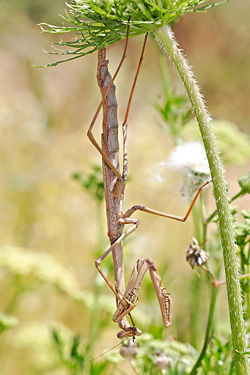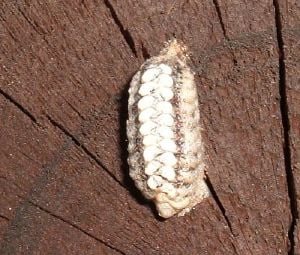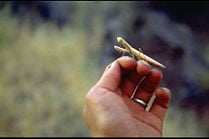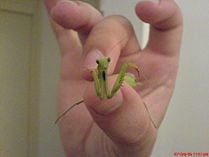Mantodea
| Mantodea | ||||||||||||||
|---|---|---|---|---|---|---|---|---|---|---|---|---|---|---|
 Large brown mantid, Archimantis latistyla hanging underneath a carrot flower
| ||||||||||||||
| Scientific classification | ||||||||||||||
| ||||||||||||||
|
Chaeteessidae |
The order Mantodea (which includes the praying mantis) consists of approximatively 2,300 species, of which a majority are in the family Mantidae. The closest relatives of mantids are the orders Isoptera (termites) and Blattodea (cockroaches), and these three groups together are sometimes ranked as an order rather than a superorder.
Mantids are notable for their large size and nimble reflexes. Their diet usually consists of living insects, including flies and aphids; larger species have been known to prey on small lizards, frogs, birds, snakes, and even rodents. Most mantids are ambush predators, waiting for prey to stray too near to them. The mantis then lashes out at remarkable speed. Some ground and bark species, however, pursue their prey rather quickly. A mantid's prey is caught and held securely with its grasping, spiked forelegs.
Mantids are masters of camouflage and make use of protective coloration to blend in with the foliage, both to avoid predators themselves, and to better snare their victims. Some species in Africa and Australia are able to turn black after a molt following a fire in the region to blend in with the fire ravaged landscape (fire melanism). In addition to this adaptation, they have adapted to not only blend with the foliage, but to mimic it, appearing as leaves, sticks, blades of grass, flowers or even stones. Their diet and coloration frequently change as the mantid grows; mantids are among the hemimetabolic insects - those whose immature stages are similar to the adults, primarily differing in the lack of wings and functional reproductive organs
Reproduction
Sexual cannibalism is common among mantids in captivity, and under some circumstances may also be observed in the field. The female may start feeding by biting off the male’s head (as with any prey), and if mating had begun, the male’s movements may become even more vigorous in its delivery of sperm. Early researchers thought that because copulatory movement is controlled by ganglion in the abdomen not the head, removal of the male’s head was a reproductive strategy by females to enhance fertilisation while obtaining sustenance. Later, this bizarre behaviour appeared to be an artifact of intrusive laboratory observation. Whether the behaviour in the field is natural, or also the result of distractions caused by the human observer, remains controversial. Mantids are highly visual creatures, and notice any disturbance occurring in the laboratory or field such as bright lights or moving scientists. Research by Liske and Davis (1987) and others found (e.g. using video recorders in vacant rooms) that Chinese Mantids that had been fed ad libitum (so were not starving) actually displayed elaborate courtship behaviour when left undisturbed. The male engages the female in courtship dance, to change her interest from feeding to mating. Courtship display was also observed in some other species, but it does not hold for all mantids. Aldous Huxley made philosophical observations about the nature of death while two mantids mated in the sight of two characters in the novel Island. The species was Gongylus gongylodes.
The mating season in temperate countries typically begins in autumn. To mate following courtship, the male usually leaps onto the female’s back, and clasps her thorax and wing bases with his forelegs. He then arches his abdomen to deposit and store sperm in a special chamber at the tip of the female’s abdomen.
Depending on the species, the female then lays between 10 to 400 eggs. These are deposited in a frothy mass that is produced by glands in the abdomen. This froth then hardens, creating a protective capsule with a further protective coat, and the egg mass is called an ootheca. Depending on the species these can be attached to a flat surface, wrapped around a plant or even deposited in the ground. In spite of the versatility and durability of the eggs, they are often preyed on, especially by several species of wasps. Variability in the species also determines whether or not the mother guards the egg pod or leaves it.
The praying mantis goes through three stages of metamorphosis: egg, nymph, and adult. Scientists also refer to this as an incomplete metamorphosis because the nymph and adult insect look essentially alike, except that the nymph is smaller and has no wings. A mantis nymph increases in size by replacing its outer body covering with a sturdy, flexible exoskeleton and molting when needed. This can happen up to five to ten times, depending on the species. After the final molt it should have full grown wings. Some species are wingless or brachypterous, particularly in the female sex.
Human perceptions
Many gardeners consider mantids to be desirable insects, as they prey upon many harmful insect species. Organic gardeners who avoid pesticides may encourage mantids as a form of biological pest control. Mantis egg cases are sold in some garden stores for this purpose.
It should be noted, however, that mantids prey on neutral and beneficial insects as well, basically eating anything they can successfully capture and devour. Although mantid diet primarily consists of small invertebrates, large mantids have been observed eating small vertebrates such as lizards, mice, snakes, and small birds such as hummingbirds.[1] The naturalist Gerald Durrell's autobiography My Family and Other Animals includes an account of a very evenly matched battle between a mantid and a gecko.
Conservation status
Only one Spanish species, Apteromantis aptera, is listed as Lower Risk/Near Threatened.
History
One of the earliest mantid references is in the ancient Chinese dictionary Erya, which gives its attributes in poetry (representing courage and fearlessness), as well as a brief description. A later text, the Jingshi Zhenglei Daguan Bencao 經史證類大觀本草 ("Bencao of the Daguan period, Annotated and Arranged by Types, Based upon the Classics and Historical Works") from 1108, is impressively correct on the construction of the egg packages, the development cycle, the anatomy and even the function of the antennae.
By the 18th century the biology and morphology of the mantids became relatively accurate. Roesel von Rosenhof accurately illustrated and described them in the Insekten-Belustigungen (Insect Entertainments).
Sources
- Tree of Life - Mantodea
- Klausnitzer, Bernhard (1987). Insects: Their Biology and Cultural History. Unknown. ISBN 0-87663-666-0.
- O'Toole, Christopher (2002). Firefly Encyclopedia of Insects and Spiders. Firefly. ISBN 1-55297-612-2.
- Checklist of Mantodea originally compiled by the Los Angeles County Museum
External links
- Phylogeny of Mantodea based on molecular data: evolution of a charismatic predator (PDF)
- Natures's Best Masked Flower Image
- Pages from Bird Watcher's Digest and RLEPhoto showing mantises eating hummingbirds.
- Do female mantids really eat their mates?
Credits
New World Encyclopedia writers and editors rewrote and completed the Wikipedia article in accordance with New World Encyclopedia standards. This article abides by terms of the Creative Commons CC-by-sa 3.0 License (CC-by-sa), which may be used and disseminated with proper attribution. Credit is due under the terms of this license that can reference both the New World Encyclopedia contributors and the selfless volunteer contributors of the Wikimedia Foundation. To cite this article click here for a list of acceptable citing formats.The history of earlier contributions by wikipedians is accessible to researchers here:
The history of this article since it was imported to New World Encyclopedia:
Note: Some restrictions may apply to use of individual images which are separately licensed.


